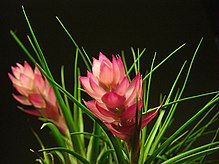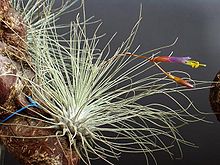PLANT CARE ( Tillandsia ) BUY NOW
 |
The optimum temperature range for Tillandsias is 50 – 90 degrees F. |
 |
Bright filtered light is the general rule, and the higher the humidity of the air the higher light will be tolerated. |
 |
Moderate humidity not less than 60%. |
 |
Water in summer abundantly with water at room temperature under the root collar about once a week. |
ADDITIONAL CARE
Tillandsia damaged leaves must be cut off in time. The plant can be grown without soil on a piece of bark, in which a hole is cut. In this hole is placed a plant whose roots must be wrapped with moss, sphagnum moss. The plant needs a rest period in winter in a humid room.
Tillandsia is a genus of around 650 species of evergreen, perennial flowering plants in the family Bromeliaceae, native to the forests, mountains and deserts of northern Mexico and the southeastern United States, Mesoamerica and the Caribbean to mid-Argentina. Their leaves, more or less silvery in colour, are covered with specialized cells (trichomes) capable of rapidly absorbing water that gathers on them.[2]
Sometimes they are also commonly known as air plants because of their natural propensity to cling wherever conditions permit: telephone wires, tree branches, barks, bare rocks, etc. Their light seeds and a silky parachute facilitate this spread.[3] Most Tillandsia species are epiphytes – which translates to ‘upon a plant’.[4] Some are aerophytes, which have a minimal root system and grow on shifting desert soil. Due to their epiphytic way of life, these plants will not grow in soil but live on the branches of trees, in deserts and on other substrates that will not be saturated with water for very long.[5]
Description
They are perennial herbaceous plants that exhibit a multitude of physiological and morphological differences making this a diverse genus. Having native habitats that vary from being epiphytic and saxicolous, species have certain adaptations, such as root systems designed to anchor to other plants or substrates, and modified trichomes for water and nutrient intake. Some of the species, like the majority of Bromeliaceae, grow as funnel bromeliads, with a compressed stem axis. The leaves are then close together in rosettes, and cover the lower areas of the leaves, forming a funnel for collecting water.
These leaf rosettes, a common physical characteristic in Tillandsia species, collect nutrients and water. The flowers typically involve bright, vibrant colours, with blooms or inflorescences produced on a stalk or several stalks. The flower’s colour varies greatly; red, yellow, purple and pink flowers exist in this genus. The bright colours attract pollinators. An air plant’s foliage may also change colour when it blooms, also attracting pollinators. The hermaphrodite flowers are threefold with the double perianth. The three free sepals are symmetrical and pointed. The seeds have a “parachute” similar to the dandelion.
Common pollinators of this genera include moths, hummingbirds and, more recently recognized, bats.
Range
They have naturally been established in diverse environments such as equatorial tropical rain forests, high elevation Andes mountains, rock-dwelling (saxicolous) regions, and Louisiana swamps, such as Spanish moss (T. usneoides), a species that grows atop tree limbs. But there are also species that live lithophytic, so on rocks (but also roofs and even telephone wires).
The green species with their claim to a cool-humid climate live mostly more in the shade terrestrial or in the lower levels of the forests.[10] In contrast, almost all grey species live in precipitation-poor areas with high humidity. Put the plant in an open area where it can receive direct sun. Many of the grey species are epiphytes. Some species are more or less xeromorphic.
Cultivation
Tillandsias, like other bromeliads, can multiply through pollination and seed formation. Since Tillandsia are not self-fertile, the pollen must come from another plant of the same species. Tillandsia, depending on the species, may take months or years to flower. After flowering, the plant forms offsets and dies.
Generally, the thinner-leafed varieties grow in rainy areas and the thick-leafed varieties in areas more subject to drought. Most species absorb moisture and nutrients through the leaves from rain, dew, dust, decaying leaves and insect matter, aided by structures called trichomes. Air plants are growing rapidly in popularity as low maintenance household plants. Due to their minimal root system and other adaptations, they generally do not require frequent watering, no more than four times a week, allowing the plant to completely dry before watering again.
The amount of light required depends on the species; overall, air plants with silver dusting and stiff foliage will require more sunlight than air plants with softer foliage. They generally need strong light. In summer outside, however, they prefer the light shade of a tree at the hottest hours. Plants are commonly seen mounted, placed in a terrarium, or simply placed in seashells as decorative pieces.[15] For so-called “aerial” species (the majority of the common species in culture except for Tillandsia cyanea), that is to say, those whose roots are transformed into crampons without any power of absorption, watering is done by the leaves in the form of frequent sprays or brief soaking of the plant in a container full of water.[16] It is imperative to use non-calcareous water. Rainwater recovered from the flow of a mossy or green roof is best for this purpose, if available.[17]
Ecology
Species of Tillandsia photosynthesize through a process called the CAM cycle, where they close their stomata during the day to prevent water loss and open them at night to fix carbon dioxide and release oxygen.[18] This allows them to preserve water, necessary because they are epiphytes. They do not have a functional root system and instead absorb water in small amounts through their leaves via small structures called trichomes. Species of Tillandsia also absorb their nutrients from debris and dust in the air.[19]
Any root system found on Tillandsia has grown to act as a fragile stabilizing scaffold to grip the surface they grow on. The plant is, therefore “greened”. Now the plant can absorb more light. When the sun dries the plants, they turn white. Thanks to this special survival trick, plants without roots can absorb fog droplets as well as rainwater and thus cover their water needs.
More than one-third of a tropical forest’s vascular plants are Tillandsia. Their contribution to the environment’s carrying capacity allows for terrestrial fauna like earthworms to thrive in the treetops.
Temperature is not critical, the range being from 10 to 32 °C (50 to 90 °F). Frost hardiness depends on the species. T. usneoides, for example, can tolerate night-time frosts down to about −10 °C (14 °F). For most species, the ideal growth temperature is between 20 and 25 °C. Few are resistant to −10 °C (14 °F), but some, usually from higher elevation areas, are hardy enough to withstand light and brief freezes and live outdoors year-round in areas with mild winters.





Liana
thanks for info